QuarkChain - One of the most promising projects in 2018?
As a strong supporter of cryptocurrency and a big blockchain enthusiast, I would like to share my thoughts on one of the most promising projects in 2018 — namely QuarkChain. After a long and an intensive research on the Internet and reading the whitepaper, I have come to the conclusion that QuarkChain has one of the most advanced technology out there and has the potential to be one of the leading blockchains in the future. In this article, I’m going to give you a review on QuarkChain and tell you why I believe that this project is one of the most promising blockchain projects in 2018.
What is QuarkChain and what makes it so special?
QuarkChain is a new innovative trustless blockchain 3.0 project that is based on a two-layered blockchain architecture aiming for 1 million TPS and seeks to achieve a high degree of scalability, security and decentralization at the same time.The problem of many blockchain technologies today is that most of them can only provide two of the aforementioned characteristics. For example, Bitcoin and Ethereum are very secure and decentralized which is also the reason why these blockchain systems are the major ones today. However, these blockchains haven’t achieved mass adoption yet because they still lack scalability. On the other hand, we could have multiple independent small blockchains and achieve a great level of decentralization and scalability. However, this approach would be very insecure because a small single blockchain is much easier to hack than a huge established one. If we take a look into the current business world, we will notice that there are already a lot of existing database solutions that scale very well and ensure a high degree of security, like BigTable, Cassandra, which have been adopted by many well-known companies. But obviously, these technologies are not decentralized.
The figure below illustrates these trade-offs:
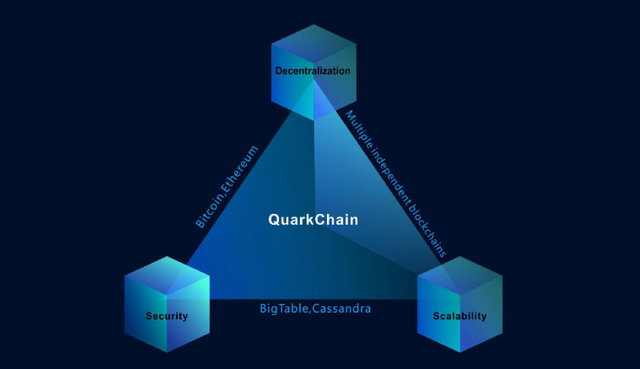
The trade-offs of blockchain technology
Now, the challenge is to provide a decentralized solution that is secure and able to scale at the same time. QuarkChain is tackling this challenge by providing a highly scalable blockchain solution while maintaining a high degree of decentralization and sufficient security. Regarding this, they propose a two-layered blockchain architecture that was inspired by developers who have previously worked in large named companies in the centralized world that handles billions of transactions.
The two-layered architecture of QuarkChain
In order to meet the global commercial standard, a novel sharding-based blockchain architecture was designed that essentially consists of two layers:1. Elastic sharding blockchain layer which contains a list of minor blockchains (shards) that processes a subset of all transactions occurring on the network.2. Root chain layer which confirms the blocks that were generated by the elastic sharding blockchain layer. This is done by including the block headers in the root blocks.
The following figure illustrates the two-layered architecture of QuarkChain:
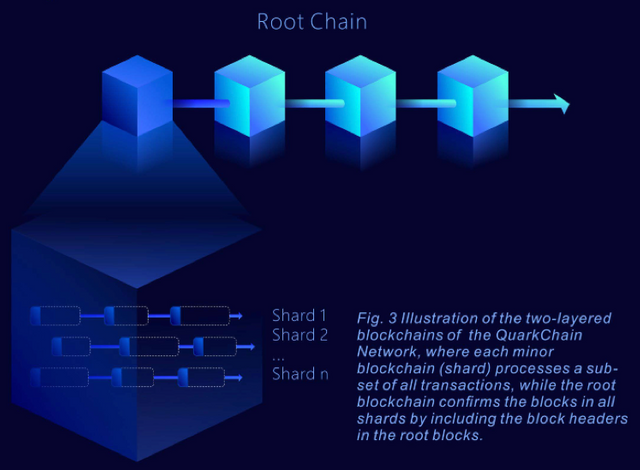
The two-layered architecture of QuarkChain
The advantage of this architecture is that the two basic main functionalities in each block within the chains are separated into different layers which reduces the complexity of the layer and leads to a higher scalability while guaranteeing the security.In addition, QuarkChain supports the ability to adjust the number of shards easily and fast as required. Regarding this, it is noted that as the number of shards increases, the more transactions can be processed concurrently by the shards. Hence, the system capacity is getting higher as more shards are being added to the network.
Collaborative mining
In order to create an open market economic model and to encourage decentralization, QuarkChain incorporates a game-theoretic framework which has several features and characteristics:
1. Shards are mined evenly because the hash power is incentivized to distribute evenly among shards.
2. Each blockchain offers different incentives and complexity which gives miners the opportunity to choose the desired blockchain with the optimal price and hash power. In this way, weak miners don’t have to join mining pools anymore which avoids centralization since the expected returns by mining solo is on the same level as joining a mining pool.
3. The behavior of selfish mining of miners is aligned with what is best for the overall system.
4. Over 50% of the whole networks hash power is assigned to the root chain which prevents double-spend attack. In fact, a malicious miner needs at least 50% * 50% = 25% total power to execute an attack on the network.
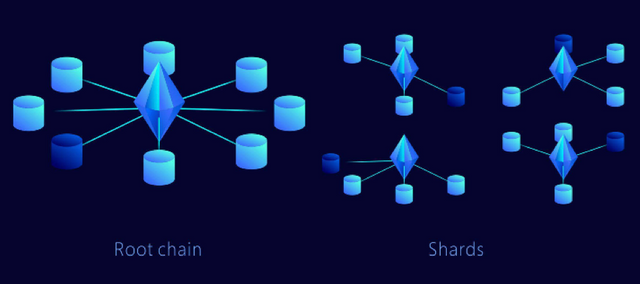
Illustration of collaborative mining where the hash power is distributed evenly among the shards
Consensus Algorithm
In order to ensure secure transactions, QuarkChain uses a hybrid POW blockchain algorithm that works in the following manner:
1. The root chain uses the same POW algorithm, which is already running on the Bitcoin and Ethereum blockchain. Regarding this, the forks with the longest length (or total difficulty) will survive in case of forking on the root chain.
2. Each shard in the sharding blockchain layer uses a conseneus called root-chain-first POW algorithm to determine which forks should survive. This is done by comparing the corresponding root chains of the forks. The fork which has the longer root chain will survive regardless how long the other fork is.
Main Features of QuarkChain
QuarkChain has a lot of features that makes it superior to many other existing blockchain solutions, which I’m going to discuss in the following.
1. Clustering
The problem of traditional blockchain technologies today, such as Bitcoin and Ethereum, is that every node needs to fully validate all blocks and reject any block that is invalid which are tasks usually executed by super-full nodes. This, however, becomes problematic in an especially high-throughput blockchain system because super-full nodes require a lot of resources and are very expensive. QuarkChain addresses this problem by introducing the concept of clustering meaning that multiple honest nodes can form a cluster and run as a super-full node but are less expensive and encourages less centralization on the network.
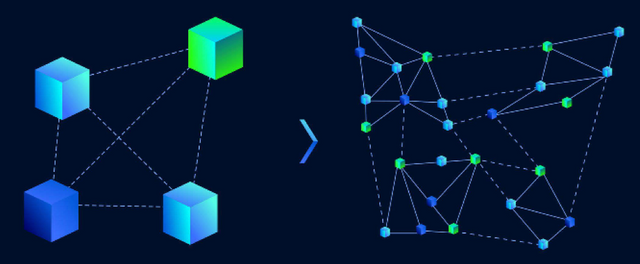
Super-full nodes (left) are replaced by clusters of nodes (right)
In fact, each node of the cluster only validates a sub-set of chains and as long as the root blockchain and minor blockchains are covered by the union of their sub-sets, the whole blockchain can be fully validated without acquiring an expensive machine. With other words, a block can still be fully validated if a node crashes in the cluster since the rest of the nodes can still form another cluster resulting in a high availability of such clusters.
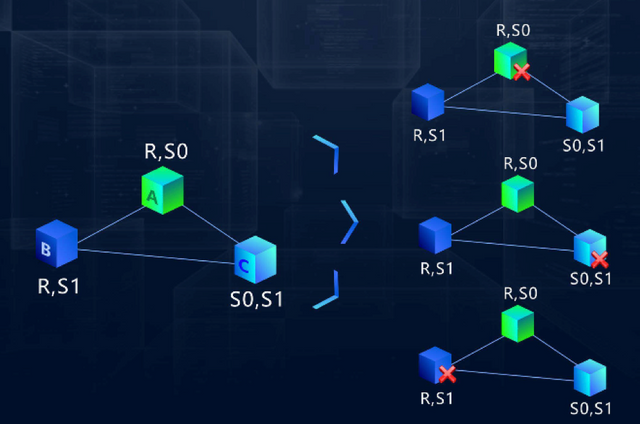
Illustration of high availability of a cluster running on the QuarkChain network with two shards
2. Cross-Shard Transactions
QuarkChain uses sharding techniques to partition the database horizontally into smaller parts to process transactions faster and to make the network more secure and decentralized. Regarding this, QuarkChain supports in-shard and cross-shard transactions meaning that transactions can be executed on the same shard (input and out addresses of the transaction are on the same shard) as well as on different shards (input and output addresses are in different shards) as long as the transactions are confirmed by the root chain.
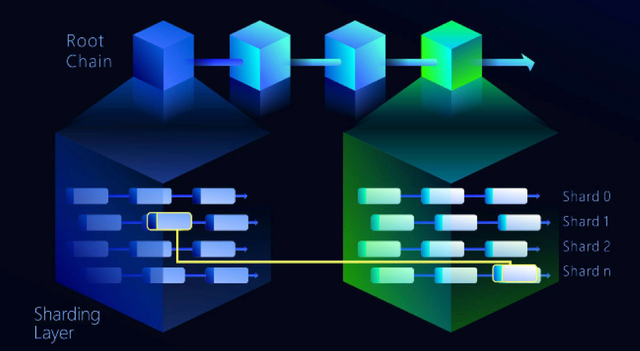
Illustration of cross-shard transactions on QuarkChain
3. Cross-Chain Transactions
The architecture design of QuarkChain supports cross-chain transactions since the QuarkChain network only maintains the one root chain. This can be done by converting the tokens using an adapter and then executing the transaction like a cross-shard transaction from the perspective of the QuarkChain network or by accommodating the other blockchain as a subchain (shard) which then becomes a cross-shard transaction.
4. On-Chain and Off-Chain TransactionsQuarkChain also provides the ability to accommodate off-chain transactions. In this regard, the two-layered sharding structure of the QuarkChain network was designed to make on-chain and off-chain handling very flexible.
5. Turing-Complete Smart Contract PlatformSince the Ethereum virtual machine (EVM) is the most widely used execution engine for smart contracts, QuarkChain has incorporated this feature on the QuarkChain network. This means that existing dApps running on the Ethereum network can be easily migrated to the QuarkChain network. Moreover, sharded blockchains run their own smart contracts local simultaneously to their blockchain via EVM which also have their unique individual wallets associated to them.
6. Simple Account ManagementIn general, a user needs multiple accounts for managing the various addresses on different shards to interact with all users/smart contracts on the network which is inconvenient. In order to simplify account management for the different shards, QuarkChain has introduced a concept which enables users to manage all addresses in every shard and to interact with all users seamless using a single account. Furthermore, smart wallet applications will be created automatically to execute cross-shard or in-shard transactions (including smart contract) for a user while the sharding mechanism remains hidden for the user.

A private key is able to execute transactions on any shard
7. Smart Wallet
QuarkChain defines the following types of accounts to further simplify account management:
A) Primary account: This account contains the address of the user in a default shard.
B) Secondary account: This account is responsible for the rest of the addresses belonging to a user in the rest of the shards.
In terms of this, the primary account is used for most times to initiate transactions and the secondary account is used as a temporarily station to move tokens through smart contract in different shards. In case if there is a remaining balance on the secondary account, the balances are transferred back to the primary account meaning that the balances reside on the primary account most of the time. As a result, the user doesn’t have to manage the addresses of the secondary account which is a feature of the smart wallet (open source). The advantage of the smart wallet is that users can transfer tokens among various addresses anytime without thinking about the different shards because cross-shard transactions are handled by the smart wallet automatically.
Roadmap
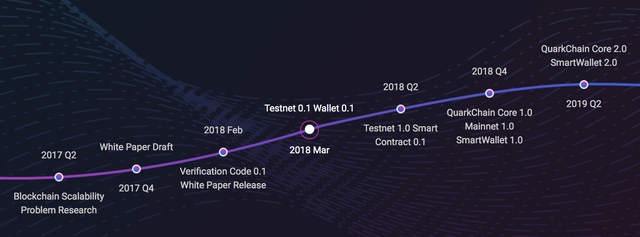
What makes me confident about this project:
· The two-layered blockchain architecture ensures efficient and secure transactions since complexities are separated into different layers and malicious attackers have to acquire sufficient hash power from the root chain and the shards.
· Anti-centralized horizontal scalability: Expensive super-full nodes can be replaced by clusters of nodes which also decreases centralization.
· The clusters of nodes ensure high scalability meaning that transactions can still be validated if a node crushes as long as the root and minor blockchains are covered by the union of their subsets.
· Network and state-sharding capabilities which also enable cross-shard transactions making this blockchain solution superior to many existing blockchain technologies from the technical perspective, like Zilliqa — one of the biggest competitors of QuarkChain.
· Speed of cross-shard transactions increases linearly as more shards are being added to the network.
· Turing-complete smart contracts support EVM natively that makes it possible to easily migrate existing dApps on the Ethereum platform to the QuarkChain network (which is also not provided by Zilliqa).
· The sharding blockchain layer can be resharded easily without changing the root chain in order to react to changing business needs which makes this blockchain very flexible.
· Collaborative mining encourages more decentralization as mining pools are avoided because the hash power is distributed evenly among the root chain and the various shards according to the mining difficulty associated with different rewards.
· Simple account management in combination with the smart wallet creates a great user experience which is very important from the user perspective (most successful IT applications today are user-friendly).
· Applied techniques in QuarkChain have already been applied in the centralized world successfully to handle billions of transactions.
· Scaling is achieved through sharding which is a better scaling solution than the lightning network approach of bitcoin because it is more flexible and transparent since all transactions are tracked on the main blockchain.· Implementing sharding on existing blockchain systems is complicated and could take a few years until it supports full cross-shard transactions, therefore it is sometimes better to just design a new system from scratch (which is often the case in the IT area).
· The Project has already a private test net operating with 8 sharded blockchains live which currently can handle 1000–2000+ TPS (note that higher TPS should be reached as more shards are being added).
· Excellent team members that have graduated from top universities and have already worked in well-known companies like Google, Facebook, Dell, Instagram etc. that dealt with billions of transactions in real time and scalability in the centralized world.
· The Project targets the mobile decentralized applications area (DApp2go) which is an area with a lot of potential since the mobile market is one of the primary engine of economic growth in our time (source: https://www.bcg.com/publications/2015/telecommunications-technology-industries-the-mobile-revolution.aspx).
Potential Considerations
Although, I’m very confident about the project, there are still some facts which must be considered:
· High competition in the blockchain area: There have already been a lot of new innovative solutions out there that have also a great technology and a strong team with the community behind it (e.g. Zilliqa, ICON, WAN, Seele, Credits, Matrix AI Network etc.).
· To perform a malicious attack on the network, a total hashing power of 25% is required which is less than other blockchains. However, due of the fact that the network is more decentralized than others, there should be less worrying.
· Considering the fact that there are some promising blockchain projects out there that have already launched their main net (or projects that are going to launch their main net earlier than QuarkChain), there is a risk of missing the first mover advantage. On the hand, QuarkChain will launch its main net at the end of 2018 which is still in the near future considering the fact that they bring a lot of new innovations to the space.
· No significant partnerships have been announced yet.
Conclusion
Scalability and performance have always been one of the major reasons why blockchain technology hasn’t been mass adopted yet. QuarkChain attempts to solve this problem by introducing a highly scalable blockchain system that is secure and decentralized in the same time. Being able to solve this problem, I think blockchain mass adoption will come even closer with QuarkChain because of its great ecosystem which serves as the fundament for new great dApps that is also able to integrate with existing blockchain systems while ensuring scalability, performance and security. In terms of this, I also believe that QuarkChain has not only the vision for an amazing blockchain, but it has also an excellent and experienced team that is able to execute that vision.
As a passionate software developer and a working IT consultant, I’m always looking for blockchain projects that have a great ecosystem where I can build new performant and robust dApps on — and QuarkChain is definitely one of those potential candidates.
From the perspective of an investor, QuarkChain is also very lucrative considering the fact that the hardcap of the project is only 20.000.000 USD (biggest competitor Zilliqa has currently a market cap of over a billion USD) and have one of the best technology out there. Therefore, this is should definitely be seen as a long-term investment in my opinion.
Finally, I believe that it won’t be the hype which leads a blockchain project to success but the technology, the team and the strong community behind it. Regarding this, I believe that QuarkChain has all of the necessary traits to become one of the leading blockchain systems in the future.
References
Website: https://quarkchain.io/
Medium: https://medium.com/@quark_30920
Telegram: https://t.me/quarkchain
Facebook: https://www.facebook.com/quarkchain.quark.5
Twitter: https://twitter.com/Quark_Chain
Weibo: http://weibo.com/QuarkChain
Github: https://github.com/QuarkChain
Disclaimer: This is not investment advice, I just share my opinion about the project on the platform. Do your own research.
Follow me on Twitter: @tienhngnguyen
Looks promising, the project is already post ico?
The ICO crowdsale will be at the end of may/begin of june I think :)
Thanks, i will have a deeper look at it